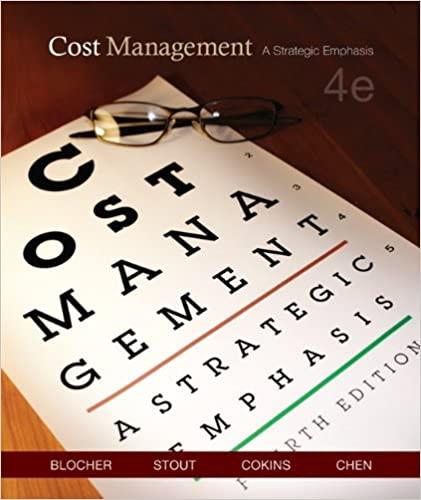Question
Problem 3-26 Journal Entries; T-Accounts; Financial Statements [LO3-1, LO3-2, LO3-3, LO3-4, LO3-5, LO3-6, LO3-7] Froya Fabrikker A/S of Bergen, Norway, is a small company that
Problem 3-26 Journal Entries; T-Accounts; Financial Statements [LO3-1, LO3-2, LO3-3, LO3-4, LO3-5, LO3-6, LO3-7]
| Froya Fabrikker A/S of Bergen, Norway, is a small company that manufactures specialty heavy equipment for use in North Sea oil fields. The company uses a job-order costing system and applies manufacturing overhead cost to jobs on the basis of direct labor-hours. Its predetermined overhead rate was based on a cost formula that estimated $388,800 of manufacturing overhead for an estimated allocation base of 810 direct labor-hours. The following transactions took place during the year (all purchases and services were acquired on account): |
| a. | Raw materials purchased for use in production, $295,000. |
| b. | Raw materials requisitioned for use in production (all direct materials), $280,000. |
| c. | Utility bills were incurred, $78,000 (95% related to factory operations, and the remainder related to selling and administrative activities). |
| d. | Salary and wage costs were incurred: |
| Direct labor (890 hours) | $ | 325,000 |
| Indirect labor | $ | 109,000 |
| Selling and administrative salaries | $ | 205,000 |
| e. | Maintenance costs were incurred in the factory, $73,000. |
| f. | Advertising costs were incurred, $155,000. |
| g. | Depreciation was recorded for the year, $91,000 (80% related to factory equipment, and the remainder related to selling and administrative equipment). |
| h. | Rental cost incurred on buildings, $105,000 (85% related to factory operations, and the remainder related to selling and administrative facilities). |
| i. | Manufacturing overhead cost was applied to jobs, $ ?. |
| j. | Cost of goods manufactured for the year, $960,000. |
| k. | Sales for the year (all on account) totaled $2,150,000. These goods cost $990,000 according to their job cost sheets. |
| The balances in the inventory accounts at the beginning of the year were: |
| Raw materials | $ | 49,000 | ||||||||||||||||||||||||||||||||||||||||||||||||||||||||||||||||||||||||||||||||||||||||||||||||||||||||||||||||||||||||||||||||||||||||||||
| Work in process | $ | 40,000 | ||||||||||||||||||||||||||||||||||||||||||||||||||||||||||||||||||||||||||||||||||||||||||||||||||||||||||||||||||||||||||||||||||||||||||||
| Finished Goods | $ | 79,000 | ||||||||||||||||||||||||||||||||||||||||||||||||||||||||||||||||||||||||||||||||||||||||||||||||||||||||||||||||||||||||||||||||||||||||||||
| ||||||||||||||||||||||||||||||||||||||||||||||||||||||||||||||||||||||||||||||||||||||||||||||||||||||||||||||||||||||||||||||||||||||||||||||
Step by Step Solution
There are 3 Steps involved in it
Step: 1

Get Instant Access to Expert-Tailored Solutions
See step-by-step solutions with expert insights and AI powered tools for academic success
Step: 2

Step: 3

Ace Your Homework with AI
Get the answers you need in no time with our AI-driven, step-by-step assistance
Get Started


